Today, intact Staffordshire wares are cherished as heirlooms or collected as antiques. At archaeological sites, fragments can help researchers date deposits and examine a variety of issues from global trade to social identity. All of the pieces pictured here were recovered during excavation of a 19th-century trash pit in Middletown, CT, thought to be associated with a property that belonged to the Southmayd (until 1825) or Vansand family. The former was a prominent merchant family, the latter a local manufacturer.
Staffordshire Pottery Excavated in Middletown
-
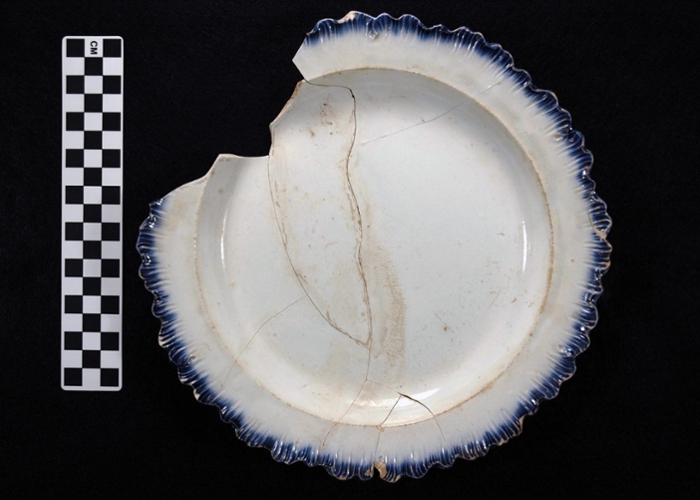
Edged Plate by Rogers
So 41
ca. 1784-1814 CE
Approximately 24.5 cm (9 1/2") diameter
So-called shell-edged wares are a common find at historical sites in the eastern U.S. These wares feature a molded edge painted in blue, green or red under the final glaze. Archaeologists have noted trends in the specific type of edge decoration over time. This plate, with its irregular edge and feathery-looking brush strokes, is one of the earlier styles, which helps narrow down the date range associated with the mark on the back. It can probably be attributed to brothers John and George Rogers, who operated a factory in Burslem, one of the six towns that make up Stoke-on-Trent. -
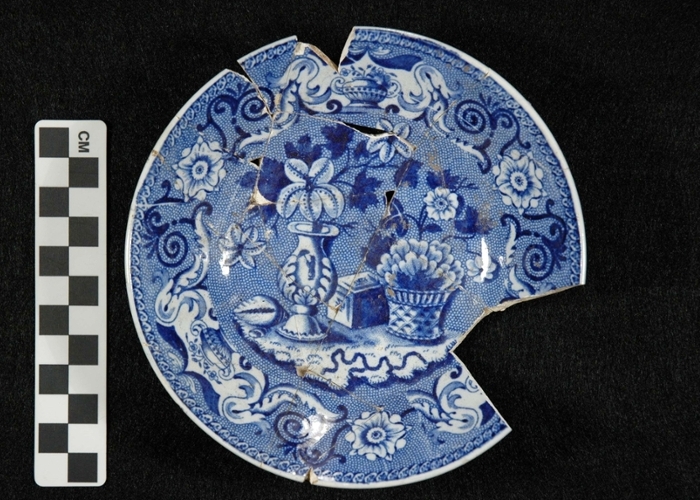
"Basket and Vase" Saucer by Ralph and James Clews
So 68
ca. 1818-1834 CE
Approximately 15 cm (6") diameter
This saucer bears the impressed "CLEWS WARRANTED STAFFORDSHIRE" mark used by Ralph and James Clews, along with other printed and impressed marks. The Clews manufactured earthenware at a factory in the Cobridge area of Stoke. The pattern is also called "Basket, Brick & Vase" or simply "Chinese Vase." Fanciful scenes evocative of western notions of "exotic" objects, plants, and animals - particularly from Asia - were popular at the time. See the Clews tea bowl (So 71) for additional information. -
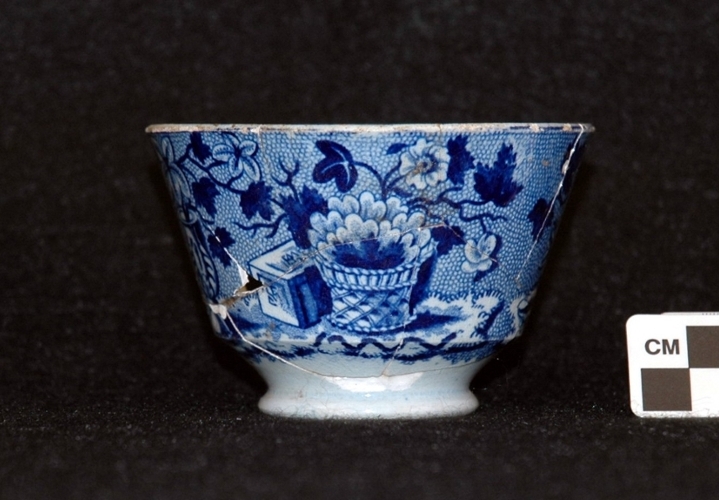
"Basket and Vase" Tea Bowl by Ralph and James Clews
So 71
ca. 1818-1834 CE
Approximately 9 cm (3 1/2") greatest diameter
This tea bowl is not actual china (hard-paste porcelain). The terms "stone china" and "ironstone china" were coined by potters to refer to various types of earthenware and stoneware developed in the early 19th century. They were cheaper to produce than true porcelain and met an increasing demand for affordable fine tablewares by the emerging middle class. The printed mark on the base is meant to evoke a Chinese export stamp, in keeping with the vaguely Chinese-inspired design. See the Clews saucer (So 68) for additional information. -
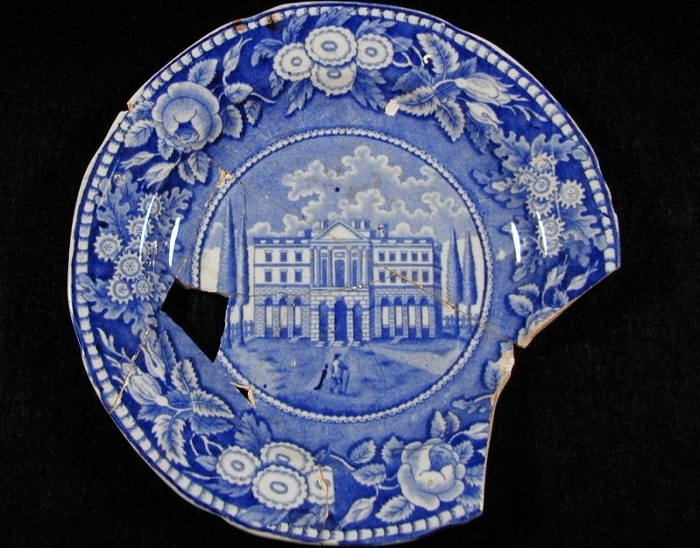
"Hartford State House" Plate by Stevenson
So 92
ca. 1815-1830 CE
Approximately 18.5 cm (7 1/4") diameter
By 1815, after the trade disruptions of the War of 1812, British potters were eager to get their wares flowing back into North American ports. They produced patterns specifically designed to appeal to this market, featuring American monuments, buildings and landscapes. This small plate by either Andrew or Ralph Stevenson depicts Connecticut's Old State House in Hartford, attributed to architect Charles Bulfinch.
In this view, the building lacks the distinctive cupola that was added in 1826, which helps date the pattern (or at least the image it was based on). Of course, patterns may be used long after they were originally engraved, but neither of the Stevensons were making pottery much beyond 1830. -
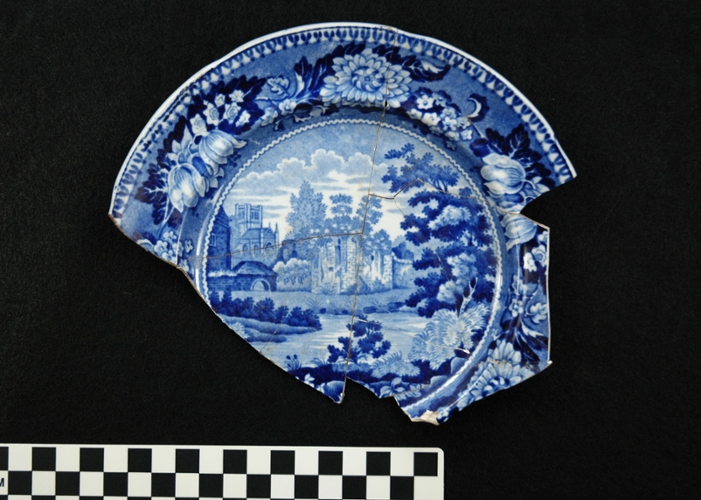
"Wolvesey Castle" Plate by Adams
So___
ca. 1820-1835 CE
Approximately 20 cm (7 3/4") diameter
This plate depicts the ruins of Wolvesey Castle in Winchester, England. The Winchester Cathedral is visible in the background. So-called "British Views" depicting England's churches, castles, and stately homes were popular domestically during the first half of the 19th century, but were also purchased by Americans whose desire to appear cultured (coupled, perhaps, with a bit of nostalgia) quickly trumped any lingering anti-British sentiment.
The impressed mark with the eagle in the center was used by William Adams and Sons ca. 1804-1840, but the pattern can be more narrowly dated to ca. 1820-1835. The same border design, in this case bluebells and other quintessentially English flowers, was often coupled with varying central views. -
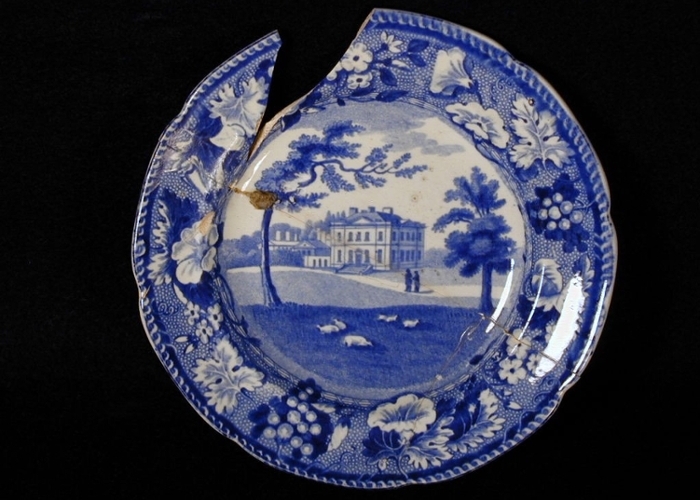
"Bickley, Kent" Plate by Enoch Wood
So 90
ca. 1815-1820 CE
Approximately 14 cm (5 1/2") diameter
This little plate lacks a trade mark, but the pattern can be attributed to Enoch Wood's "Grapevine Border" series. The bucolic scene features a manor house in Bickley, a wealthy area on the margins of London. Note the detail at upper right, where the edge of the flower is truncated. Designs were transferred from engraved, inked copper plates to the unglazed ceramics via thin sheets of damp tissue paper. In this case, it appears that the border transfer was misaligned when it was applied, or that a design intended for a larger plate was cut down to size. -
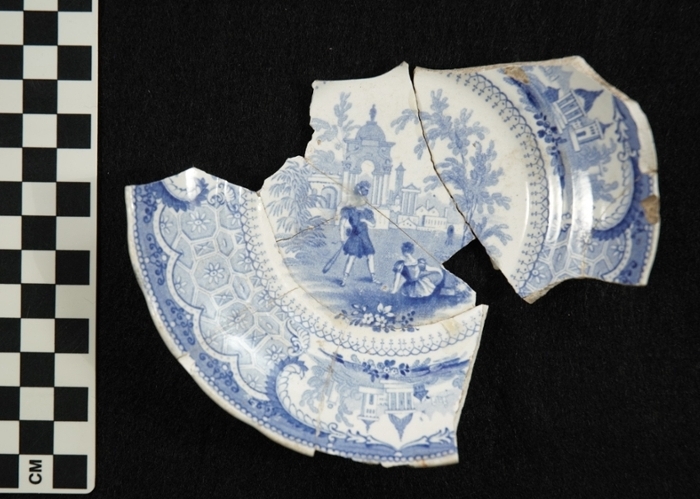
"Olympic Games" Pattern Saucer by Thomas Mayer
So 143
1831 CE
Approximately 15 cm (5 7/8") diameter
Created before the advent of the modern Olympics, Thomas Mayer's "Olympic Games" series likely catered to a western fascination with ancient civilizations, particularly those of Greece and Rome. Each pattern in the series is dedicated to a different sport or skill associated with classical times, such as wrestling, archery, or in this case, the sling. The scenes are fanciful, set outdoors amidst trees and flowers before an array of neoclassical buildings. Note that the figure demonstrating the sling is wearing a classically-inspired costume, while the woman watching is clad in contemporary fashion.
The printed trade mark indicates that it was made in 1831, when Mayer operated out of the Cliff Bank Works in Stoke. The exact meaning of the small cross within a circle is unknown, but it may be related to the ware type or year of manufacture. -
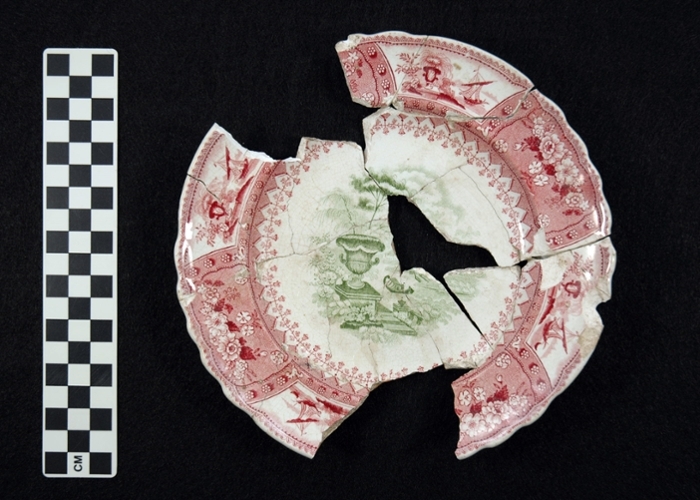
"Canova" Pattern Plate by Thomas Mayer
So 177
ca. 1826-1835 CE
Approximately 19 cm (7 1/2") diameter
Although blue was the most common color used on transfer-printed ware, it was also produced in shades of brown, black, purple, red and green. Mayer's popular "Canova" pattern, shown here, was printed in various colors. It is named after Antonio Canova (1757-1822), an Italian neoclassical sculptor whose life and works were popularized in England by a monograph published shortly after his death. Supposedly, his heart was removed and entombed in a porphyry urn as a relic. This tale may be the inspiration for the prominent urn in the central scene. The urn motif is repeated in the border alongside a Venetian galley, alternating with panels of flowers. See object So 188 for another version of this pattern. -
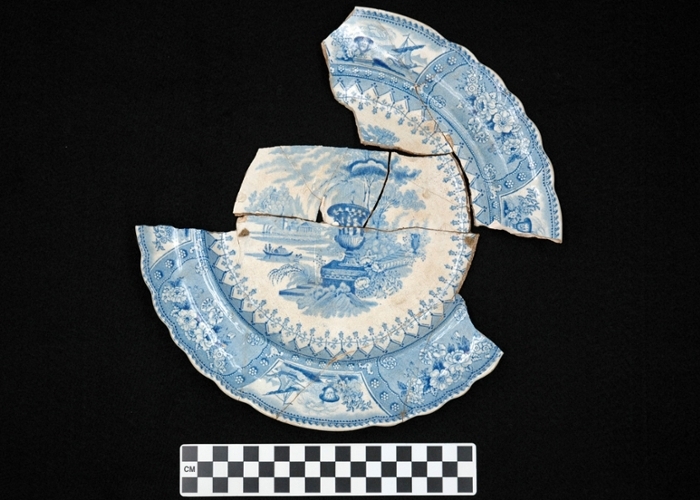
"Canova" Pattern Plate by Thomas Mayer
So 188
ca. 1826-1835 CE
Approximately 27 cm (10 3/4") diameter
This plate, along with So 43 and So 177, were manufactured by Thomas Mayer operating out of the Cliff Bank Works in Stoke. The small blue printed mark, seen at upper right in the trade mark detail, may be related to the ware type or year of manufacture. It appears to be the alchemical symbol for iron (also used as the astronomical symbol for Mars and the biological symbol for male).
This is another version of the "Canova" pattern seen on So 177 (see that record for details). One notable difference is the central urn, which in this version is decorated with draped classical figures.